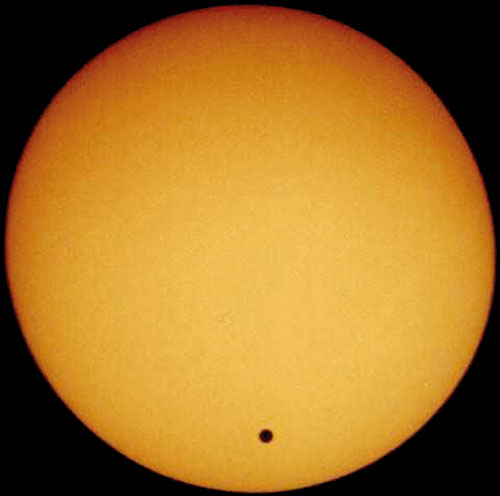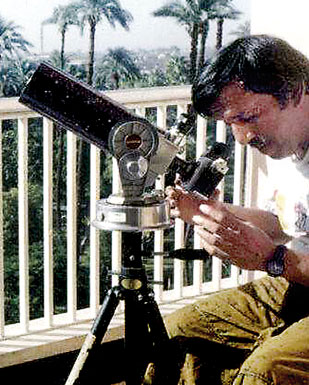An eclipse of the Sun occurs when the Moon passes directly in front of the Sun. Since the planets Mercury and Venus orbit inside the path of the Earth around the Sun, they too can come between the Earth and the Sun. However since these planets have a tiny apparent diameter as seen from Earth, the Transit is seen as a small black disk moving across the face of the Sun.
Transits of Mercury occur on average once in 7.4 years. Mercury's 10 seconds of arc apparent diameter is just a tiny 0.5% of the Sun.
 |
| 2004: The last time this rare phenomena occurred |
Transits of Venus are among the rarest of predictable astronomical phenomena. They occur with pairs of transits eight years apart separated by long gaps of 105.5 years and 121.5 years. The diameter of Venus at 58 seconds of arc is 3% of the Sun. It is barely visible to the naked eye without any magnification.
Since the invention of the telescope, the first known observation, was made by Jeremiah Horrocks from his home near Preston in England on December 4, 1639. As an early example of international scientific collaboration, for the next Transit of Venus in 1761, numerous expeditions from Britain, Austria and France travelled to destinations around the world, so that precise observations could be made to calculate the distance to the Sun, as proposed by Edmund Halley in 1678. On the basis of his observation from the Petersburg Observatory, Mikhail Lomonosov predicted the existence of an atmosphere on Venus.
 |
| The writer observing the phenomena in 2004 from a Luxor hotel balcony |
Captain Cook set sail from Plymouth on the Endeavour in August 1768 on his first voyage to observe the June 1769 transit from Tahiti. The second part of this mission was to seek evidence of the "unknown southern land" which he discovered and established British sovereignty over -Australia.
The last Transit of Venus in our lifetime will happen on June 6, in just 10 days. Looking at the visibility and the global cloud cover map for June posted on the Internet (http://home.cc.umanitoba.ca/~jander/tov2012/tovintro.htm) the ideal location to see the entire event in clear skies, is North central Australia. Clearly not as inviting as Luxor in Egypt from where I observed the previous transit on June 5, 2004. See http://lakdiva.org/2004egypt/transit.html
The 6 hour 40 min event will start at 3:39 a.m., just over two hours before east coast Sunrise in Sri Lanka at 5:46 a.m. and we will see the remaining part of it until around 10:21:42 (Contact IV). So the most interesting part of the Transit from Sri Lanka is when Venus starts to leave the solar disk at 10:04:18 (Contact III), since we don't see Venus enter.
At the critical moment when observers try to time when Venus touches the inside edge of the Sun disk, an optical phenomena known as the black drop effect has been well documented. There are many explanations, mostly by instrumental astigmatism and atmospheric seeing.
Except when it is very close to the horizon at sunrise and sunset, NEVER view the Sun with the naked eye. This can cause permanent eye damage or blindness. Any optical device, such as camera, binoculars or a telescope MUST have special solar filters attached to the front of the instrument that let in only 1 part in 400,000 of the sunlight. Unlike a solar eclipse when one could use shade 14 welding glass as a filter, they will distort the view of Venus, since they are not optically flat.
To see the transit, the image of the Sun could be safely projected on a white board, using a telescope with a proper solar filter. I do remember using this method to observe the Transit of Mercury on May 9, 1970 as a student of Royal College. Many could observe at the same time, and the path can be plotted on a paper. The Colombo Planetarium has included this rare event in its regular lectures to schools this year. Weather permitting they will show the transit to the public who visit that day. However because of the South West Monsoon, it is probably better to move out of the Western Province and go north east to improve the probability of having a clear sky.
 |
| Visibility of Transit of Venus on June 6 |
Whatever you plan to use to look at or photograph the Transit, try it out a few days before to see if you can observe sunspots. Venus will be slightly simpler to observe. Keep track of the daily morning weather from your site and decide if you need to move to a better location with clear skies. Clouds hamper observations of a transit since you need 30 times higher resolution to observe Venus than the Sun.
If you didn't see the Transit of Venus in 2004, this Transit of Venus will truly be a once in a lifetime opportunity. The next Transit of Venus is in 105 years in 2117, when nearly everyone living today would have passed away.
For more information – please see http://www.transitofvenus.org/june2012/eye-safety/281-six-ways-to-see-the-transit-of-venus |
